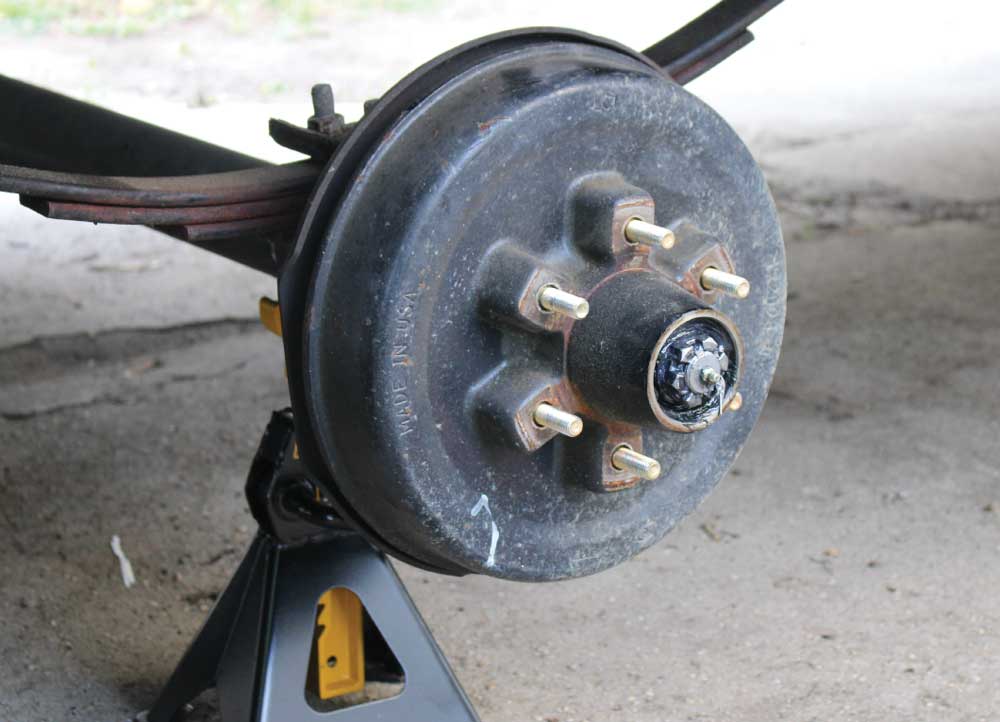Trailer Brake Failure: One Side Not Working - A Comprehensive Guide
Imagine this: You’re towing your boat to the lake for a weekend getaway, navigating a winding mountain road. Suddenly, you feel a disconcerting pull. Your trailer brakes aren't working correctly, and the imbalance is creating a dangerous situation. This isn't just an inconvenience; it's a serious safety hazard. One-sided trailer brake failure can lead to loss of control, jackknifing, and even accidents. This guide will explore the issue of trailer brakes failing on one side, diving into the causes, solutions, and preventive measures you can take to ensure safe and worry-free towing.
Uneven braking performance in trailers can stem from a variety of problems. These can range from simple issues like incorrect brake adjustment or air leaks in the brake lines to more complex problems like faulty brake magnets, damaged wiring, or even a malfunctioning brake controller. Understanding the potential causes is crucial for effective diagnosis and repair.
Trailer brakes are essential for safe and controlled towing, especially with heavier loads. Historically, trailers relied solely on the towing vehicle's brakes. However, as trailers became larger and heavier, the strain on the towing vehicle's braking system increased significantly, leading to longer stopping distances and potential overheating. This highlighted the need for independent braking systems on trailers, paving the way for the development of electric and hydraulic brake systems.
The importance of functioning trailer brakes cannot be overstated. They provide supplemental braking power, reducing the burden on the towing vehicle’s brakes and improving overall stopping distance. When one side of the trailer brakes fails to engage, it creates an uneven braking force, which can cause the trailer to sway or pull to one side, making it challenging to control, particularly in emergency situations or during downhill descents.
Diagnosing a one-sided brake failure involves a systematic approach. Start by checking the brake adjustment on both wheels. Uneven adjustment can lead to one brake engaging more forcefully than the other. Inspect the brake lines for any signs of damage, leaks, or kinks, especially if you have an air brake system. For electric brakes, examine the wiring for any loose connections, corrosion, or breaks. Test the brake magnets to ensure they are functioning correctly.
If your trailer brakes are not working on one side, a professional mechanic specialized in trailer repair is your best resource. They have the expertise and tools to diagnose the problem accurately and carry out the necessary repairs.
Advantages and Disadvantages of Addressing One-Sided Trailer Brake Failure
| Advantages | Disadvantages |
|---|---|
| Increased Safety | Cost of Repair |
| Improved Towing Control | Time Investment for Diagnosis and Repair |
| Reduced Wear on Tow Vehicle Brakes | Potential Inconvenience if Breakdown Occurs on the Road |
There are unfortunately no benefits to having trailer brakes not working on one side, only dangers.
Troubleshooting Steps for Trailer Brakes Not Working on One Side:
1. Check Brake Adjustment: Ensure both sides are adjusted equally.
2. Inspect Brake Lines: Look for leaks, kinks, or damage.
3. Test Brake Magnets (Electric Brakes): Use a multimeter to check for proper function.
4. Examine Wiring: Look for loose connections, corrosion, or breaks.
5. Consult a Qualified Mechanic: If you are unable to identify the problem, seek professional assistance.
Frequently Asked Questions:
1. Why are my trailer brakes only working on one side? Potential causes include uneven brake adjustment, faulty brake magnets, wiring issues, or problems with the brake controller.
2. Can I drive with trailer brakes not working on one side? It is strongly discouraged and unsafe to tow with malfunctioning trailer brakes. It can lead to loss of control and accidents.
3. How do I test my trailer brake magnets? Use a multimeter to check for continuity and resistance.
4. How often should I inspect my trailer brakes? It is recommended to inspect your trailer brakes before each trip and have them professionally serviced annually.
5. What are the signs of failing trailer brakes? Uneven pulling, longer stopping distances, and overheating brakes are potential indicators.
6. How much does it cost to repair trailer brakes? The cost varies depending on the extent of the damage and the type of brake system.
7. Can I fix trailer brakes myself? While some minor adjustments can be done DIY, complex repairs are best left to qualified professionals.
8. How do I adjust trailer brakes? Consult your trailer owner’s manual for specific instructions on how to adjust your trailer’s brake system.
Tips and Tricks for Maintaining Trailer Brakes:
Regularly inspect brake components for wear and tear. Lubricate moving parts as needed. Test your trailer brakes before every trip to ensure they are functioning properly.
In conclusion, addressing the issue of trailer brakes not working on one side is crucial for ensuring safe and controlled towing. Understanding the potential causes, taking preventive measures, and knowing how to troubleshoot the problem empowers you to maintain a safe towing experience. Ignoring a one-sided brake failure can have serious consequences, leading to loss of control, accidents, and potentially putting yourself and others at risk. Regular inspections, proper maintenance, and prompt repairs are vital to maintaining the safety and reliability of your trailer's braking system. Don’t hesitate to seek professional assistance if you encounter any problems you can’t resolve yourself. Remember, safety is paramount when towing, and investing in proper brake maintenance is an investment in your peace of mind on the road. Take action today to ensure your trailer brakes are in optimal condition for your next towing adventure. By prioritizing brake safety, you'll contribute to a safer towing environment for everyone.
Anime pfp 1080x1080 goku power up your online persona
Unleash your inner maker a guide to craft vendor events this weekend
Decoding the jpmorgan chase bank address matrix













